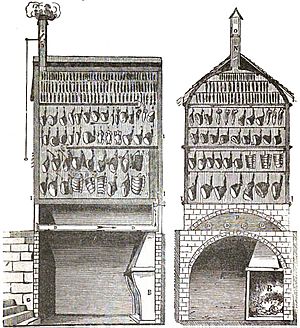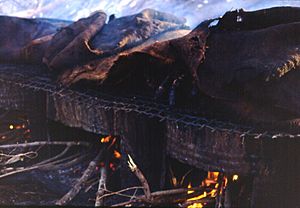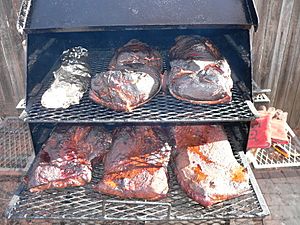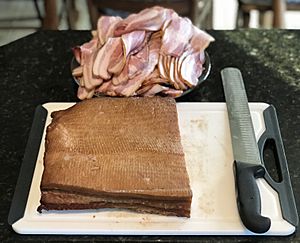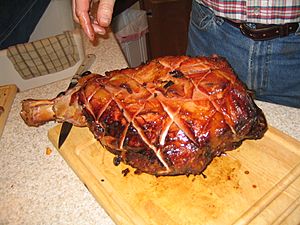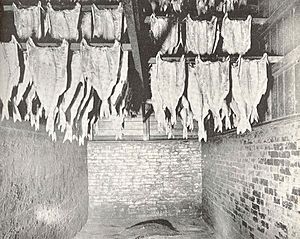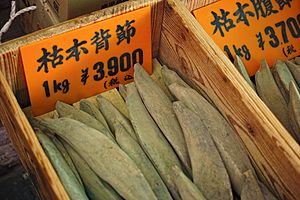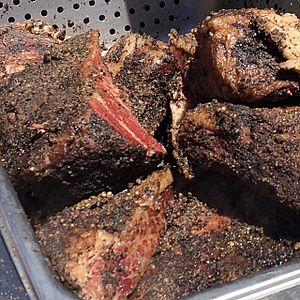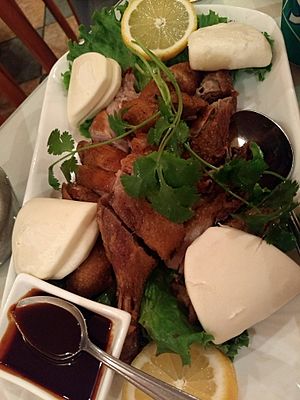Smoked meat facts for kids
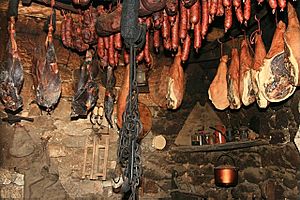
Smoked meats
|
|
| Type | Meat or fish |
|---|---|
| Main ingredients | red meat, white meat, fish, spices, smoke |
Smoked meat is food like red meat, white meat, or seafood that has been treated with smoke. This way of preparing food started a very long time ago, in the Paleolithic Era (Stone Age).
Smoking meat does a few cool things:
- It adds a delicious flavor.
- It makes the meat look better.
- It helps keep the meat fresh for longer, especially when combined with a process called curing.
When meat is cured and then smoked at a low temperature (cold smoking), the smoke adds special chemicals. These chemicals help stop tiny germs from growing on the meat. Smoking at a higher temperature (hot smoking) is mostly for taste and to cook the meat slowly. People all over the world are becoming more interested in barbecue and smoking food!
Contents
How Wood Helps Smoke Meat
People usually smoke meat using hardwood or small pieces of wood called wood pellets. Softwoods are not recommended because they can release more unhealthy chemicals.
Wood smoke gives food its unique flavor and smell. It also helps keep food from spoiling. There are two main ways to smoke:
- Cold smoking happens below 90 °F (32 °C). This method is better for preserving food.
- Hot smoking happens above 160 °F (71 °C). This method is mostly for cooking and adding flavor.
Most wood used for smoking is "seasoned," meaning it has been dried out. "Green wood" (freshly cut wood) is usually not used.
Here are some types of wood used for smoking:
- Mild flavor: Alder, apple, apricot, ash, birch, cherry, maple, peach, pear.
- Medium flavor: Almond, hickory, pecan, post oak, pasania.
- Strong flavor: Acacia, black walnut, chokecherry, grapevine, mesquite.
- Other woods and plants: Avocado, bay, beech, butternut, carrotwood, camphor, castanopsis, chestnut, citrus woods, cottonwood, crabapple, fig, guava, gum, hackberry, kiawe, lilac, madrone, mulberry, olive, peat, plum, persimmon, pimento, tea, and willow.
Different Kinds of Smoked Meat
Smoked Fish in Africa
In many African nations, about 80% of all fish caught is smoked. Women have traditionally been in charge of preparing and smoking fish. The main way they smoke fish is through hot smoking. People in these areas prefer the taste that hot smoking gives.
Old ways of smoking fish included using bamboo racks over smoky fires. They also used mud ovens or placed fish directly on slow-burning wood and grass. Today, people use modern methods like old oil drums, brick ovens, and special Chorkor ovens for smoking fish.
American Barbecue (Smoked)
American barbecue started with Native Americans. They smoked fish and game to save food for times when it was harder to find. When Europeans came to North America, they brought their own smoking methods. They then mixed these with the Native American ways.
American barbecue has different styles depending on the region:
- North Carolina Piedmont style uses pork shoulder with a vinegar and ketchup sauce.
- Eastern style uses a whole hog with a vinegar and pepper sauce.
- South Carolina uses a whole hog or shoulder with a mustard sauce.
- Western Tennessee and Memphis are famous for their dry rub ribs. Wet ribs are also popular.
- Kentucky is known for mutton, but pork shoulder and whole hog are also common.
- Kansas City barbecue is known for its sauce. It is often used with smoked pork, lamb, chicken, beef, and turkey.
- Texas barbecue often features Beef ribs, smoked sausage, and brisket.
Bacon
Bacon has a long history, going back to a Roman food called petaso. The word "bacon" might come from old French, German, or Dutch words. John Harris of Calne, England, was the first person to start selling bacon in large amounts in the 1770s.
Bacon is mostly made from pork. It can come from different parts of the pig, like the belly, back, or side. How bacon is made depends on the type, but most kinds are cured and smoked.
Some types of bacon include:
- American (also called side bacon or streaky bacon)
- Canadian (back bacon)
- British and Irish (rasher)
- Italian (pancetta)
- German (speck)
Bacon can also be made from beef, lamb, and wild game.
Country Ham
Country ham is a popular type of ham. It was first made by American Colonists. They learned from Native Americans how to smoke fish and then used those skills for pork. Country hams were traditionally made in the American Southeast, from Virginia to Missouri.
Most country hams are trimmed, wrapped, and cured in salt, sugar, pepper, and other spices. Today, some people add special salts to help keep the food safe. After curing, the hams are smoked for at least 12 hours. Then, they are hung to dry for 9 to 12 months. Some traditional methods can take years before the ham is ready to eat!
Finnan Haddie
Finnan haddie is haddock fish that has been cold smoked. It started in the Middle Ages in a Scottish village called Findon. Traditionally, the haddock is smoked using green wood and peat (a type of fuel made from decayed plants).
Smoked finnan haddie is the color of straw (light yellow). Newer ways of drying the fish without smoke can make it gold or yellow. Until the 1800s, when trains started running regularly, finnan haddie was mostly a local dish. Now, you can find it in markets all over the world.
Katsuobushi
Katsuobushi is a very important ingredient in Japanese cuisine. It adds a rich, savory umami flavor. Bonito flakes, which are used in many dishes, are made from katsuobushi.
Katsuobushi is made from skipjack tuna. The fish is washed, cut into quarters, and then smoked with oak, pasania, or castanopsis wood. This smoking and cooling process is repeated for about a month. Some makers even spray the fish with a special mold to help it dry more. After one to 24 months, the fish becomes very hard, like wood. To make bonito flakes, it is shaved into very thin pieces using a special grater box.
Pastrami
Pastrami is usually made from beef brisket, but other cuts of beef can also be used. The meat is cured in a salty liquid called a brine, often a dry one. After drying, it is covered in spices and smoked. It can be smoked using either cold or hot smoking methods.
Pastrami's story goes back to the Huns, a group of people from long ago. They would make meat tender and dry it under their saddles. Armenians saw this and created basturma, which was spiced and air-dried meat. Later, Romanians started brining, spicing, and smoking beef, creating what we now call pastrami.
When Romanian Jews moved to the United States, Canada, and Great Britain in the late 1800s, they brought this tradition with them. Those who moved to New York City developed the classic New York Pastrami. Those who went to Montreal used different brining and spices, calling it smoked meat.
Pastrami is still made in Southwest Asia and the Middle East and is called Pastirma, basterma or basturma. While usually made with beef, it can also be made with lamb, goat, buffalo, and camel. Corned beef uses a similar brine and spices but is not smoked.
Zhangcha Duck
Zhangcha duck is a special dish from the Sichuan Province in China. It is made from a type of duck called Chengdu Ma duck. The duck is first soaked in a special liquid (a pickling liquid). Then, it is smoked using camphor and tea leaves. After smoking, the duck is deep fried, the bones are removed, and it is served over rice.
Staying Safe with Smoked Foods
It's important to know that eating smoked foods often might be linked to some health concerns. For example, some studies have looked at a small group of people where their traditional smoking process created higher levels of certain substances.
Also, smoked meats can sometimes allow a type of bacteria called Listeria to grow. While rare, this bacteria can cause serious problems, especially for babies. It's always best to make sure smoked foods are prepared and stored safely.
Using soft woods for smoking is not a good idea. The sticky sap in softwoods can increase the amount of certain chemicals called PAHs. These chemicals are known to be harmful.
See also
 In Spanish: Carne ahumada para niños
In Spanish: Carne ahumada para niños


